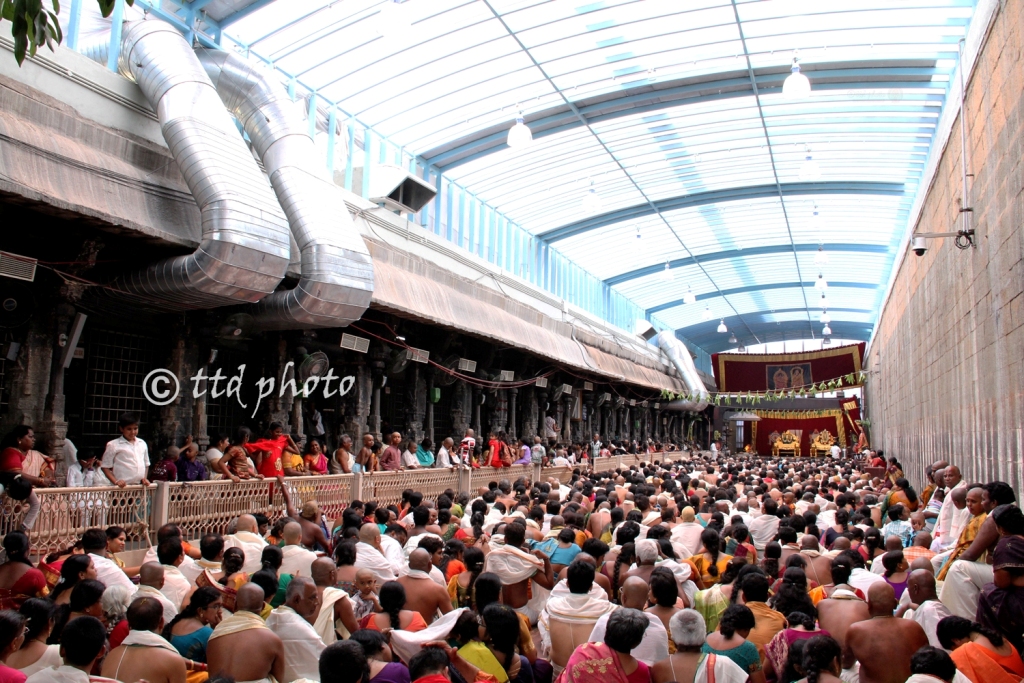Kalyana Mandapam or Kalyanotsava Mandapam
The lush green forests of Seshachala house, Sri Venkateswara Swamy, who is also revered as Perumal, Venkatachalapati, Tirumalesa, Govinda, Balaji, Srinivasa and many more names.
Mandapams – Tirumala Temple
The ancient temple of Lord Venkateswara in the hill shrine of Tirumala is an amazing complex of history, culture, and traditions. Almost every brick speaks volumes about the cultural journey of the temple over the past several centuries.
According to saint poet Sri Tallapaka Annamayya, the various Mandapams and constructions inside the Srivari temple served as shelters to the devotees at times of heavy rains and scorching summer besides being served as platforms for temple rituals and stand here to tell the volumes of history.
These temples not only have historical and mythological significance but also stand as architectural marvels. A peep into these mandapams:
- Dwajasthambha mandapam,
- Krishnadevaraya Mandapam,
- Four Pillar Mandapam,
- Ranganayakula Mandapam or Ranga Mandapam,
- Kalyanotsava Mandapam,
- Tirumalaraya Mandapam,
- Anna Unjal Mandapam,
- Addala Mandapam or Aina Mahal,
- Garuda Mandapam,
- Golla Mandapam,
- Sahasra Deepalankara Seva Mandapam etc.
Let us have a short glimpse related to these mandapams in this issue (this page is dedicated to Kalyana Mandapam). Click here for all mandapams.
Kalyana mandapam
On the south-western comer of the Vimana pradakshina is a spacious Kalyana Mandapam noted for its exquisite sculptures. It is 80 feet x 36 feet Architecturally it is similar to the Tirumalaraya mandapam. At its western end is situated a small shrine of black granite containing four pillars each with three pillars projecting.
Behind this shrine is a raised portion called the Yagasala. The pillars show a variety of patterns some with alternate square and octagonal sections and some with very intricately chiseled tops having heavy capitals. The four-pillared central sub mandapa built of polished black granite has extremely beautiful florid workmanship.
Its side walls are decorated with the series, pilaster, pilaster kumbha panjara, salakoshta.
The array of female dancers that crowd the inner fringes of the roof and the exquisite miniature sculptures that adorn all faces of the pillars lend a touch of delicacy and charm to the structure. Perhaps this intricate workmanship is taken over from the art of ivory carving for which the Hoyasala art is so famous.
The Kalyana mandapa and its sub-mandapa contain numerous relief sculptures on their pillars like Trivikrama sudarshana, sixteenarmed Narasimha, Laxmi Narasimha, Hayagriva etc. From the day of the Dhwajarohanam of the Brahmotsavam to the Dipavali day, Lord Malayappan resides here and not in the sanctum sanctorum.
Similarly for twenty-three days, in December in connection with the adhyayanotsavam the asthanams take place in this mandapa only.
Vimana pradakshina
This is a quadrangular space enclosed between the walls of the second prakara, the inner gopuram, and the walls of the first prakaram which surround the sanctum.
The open space of this pradakshina between the gateway of the inner gopuram and the Tirumamani mandapam to its west or Mukhamandapam, is hardly 18 feet. In addition to the structures composing the main Vimana, there are many large cut-stone structures, shrines, and mantapams within the Vimana pradakshina.
These leave a comparatively narrow width of open space surrounding the main temple. It is this open space that is now known as Vimana pradakshina. Pilgrims who have taken a vow of anga pradakshina perform it only in this courtyard.

